Battles which Muslims won with a smaller army,part 1
Battles which Muslims won with a smaller army
1. The Battle of Badr (Arabic: غَزْوَةُ بَدِرْ Arabic pronunciation: [ɣaz'wat'u ba'dir]), also referred to as The Day of the Criterion (Arabic: يَوْمُ الْفُرْقَانْ, Arabic pronunciation: [jawm'ul fur'qaːn]) in the Qur'an and by Muslims, was fought on Tuesday, 13 March 624 CE (17 Ramadan, 2 AH), near the present-day city of Badr, Al Madinah Province in Saudi Arabia. Muhammad, commanding an army of his Sahaba, defeated an army of the Quraysh led by Amr ibn Hishām, better known as Abu Jahl. The battle marked the beginning of the six-year war between Muhammad and his tribe. Prior to the battle, the Muslims and the Meccans had fought several smaller skirmishes in late 623 and early 624.
Muhammad took keen interest in capturing Meccan caravans after his migration to Medina, seeing it as repayment for his people, the Muhajirun. A few days before the battle, when he learnt of a Makkan caravan returning from the Levant led by Abu Sufyan ibn Harb, Muhammad gathered a small expeditionary force to capture it. Abu Sufyan, learning of the Muslim plan to ambush his caravan, changed course and took a longer route away from Muhammad's base at Medina and sent a messenger to Mecca, asking for help. Abu Jahl commanded an army nearly one-thousand strong, approaching Badr and encamping at the sand dune al-'Udwatul Quswa.
Badr was the first large-scale engagement between the Muslims and Qurayshite Mecca. Advancing from the north, the Muslims faced the Meccans. The battle began with duels between the warriors on both sides, following which the Meccans charged upon the Muslims under a cover of arrows. The Muslims countered their charge and broke the Meccan lines, killing several important Quraishi leaders including Abu Jahl and Umayyah ibn Khalaf.
The Muslim victory strengthened Muhammad's position; Medinans eagerly joined his future expeditions and tribes outside Medina openly allied with Muhammad.[2] The battle has been passed down in Islamic history as a decisive victory attributable to divine intervention, and by other sources to the strategic prowess of Muhammad.
| Battle of Badr | |||||||
|---|---|---|---|---|---|---|---|
| Part of Muhammad's campaign against the Quraish | |||||||
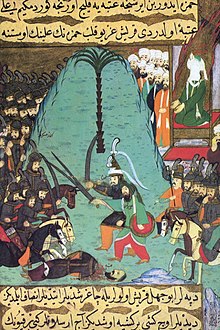 Scene from Siyer-i Nebi, Hamza and Ali leading the Muslim armies at Badr. The writing is Ottoman Naskh. | |||||||
| |||||||
| Belligerents | |||||||
| Muslims of Madinah | Quraish of Makkah | ||||||
| Commanders and leaders | |||||||
| Muhammad az-Zubayr bin al-'Awwam al-Miqdad bin 'Amr Hamza ibn Abd al-Muttalib Ali ibn Abi Talib 'Ubaydah bin al-Harith † | Amr ibn Hishām † Utbah ibn Rabi'ah † Umayyah ibn Khalaf † Shaybah ibn Rabi'ah † Walid ibn Utbah † Uqba ibn Abi Mu'ayt † | ||||||
| Strength | |||||||
Total: 313-317 | Total: 950-1000
| ||||||
| Casualties and losses | |||||||
Total: 14 killed
| 70 killed, 70 prisoners[1][f] | ||||||
2.The Battle of the Trench (Arabic: غزوة الخندق, romanized: Ghazwat al-Khandaq), also known as the Battle of Khandaq (Arabic: معركة خندق, romanized: Ma’rakah al-Khandaq) and the Battle of the Confederates (Arabic: غزوة الاحزاب, romanized: Ghazwat al-Ahzab), was a 27-day-long defence by Muslims of Yathrib (now Medina) from Arab and Jewish tribes. The strength of the confederate armies is estimated around 10,000 men with six hundred horses and some camels, while the Medinan defenders numbered 3,000.
The largely outnumbered defenders of Medina, mainly Muslims led by Islamic Prophet Muhammad, dug a trench on the suggestion of Salman the Persian,[5] which together with Medina's natural fortifications, rendered the confederate cavalry (consisting of horses and camels) useless, locking the two sides in a stalemate. Hoping to make several attacks at once, the confederates persuaded the Muslim-allied Medinan Jews, Banu Qurayza, to attack the city from the south. However, Muhammad's diplomacy derailed the negotiations, and broke up the confederacy against him. The well-organised defenders, the sinking of confederate morale, and poor weather conditions caused the siege to end in a fiasco
The siege was a "battle of wits", in which the Muslims tactically overcame their opponents while suffering very few casualties. Efforts to defeat the Muslims failed, and Islam became influential in the region. As a consequence, the Muslim army besieged the area of the Banu Qurayza tribe, leading to their surrender.
The defeat caused the Meccans to lose their trade and much of their prestige.[4]
| Battle of the Trench | |||||||
|---|---|---|---|---|---|---|---|
| Part of the Muslim–Quraysh Wars | |||||||
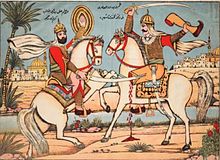 Combat between Ali ibn Abi Talib (left) and Amr ibn Abd al-Wud (right) during the Battle of the Trench | |||||||
| |||||||
| Belligerents | |||||||
Muslims Including | Confederates including
| ||||||
| Commanders and leaders | |||||||
| Muhammad Ali Ibn Abi Talib Salman the Persian 'Ubadah ibn al-Samit[2] | Abu Sufyan Amr ibn Abd al-Wud † Tulayha | ||||||
| Strength | |||||||
| 3,000[3] | 10,000[3] | ||||||
| Casualties and losses | |||||||
1~5 people (Reportedly 4) Light[4] | 10 people Extremely heavy[4] | ||||||
To check the Arab advance and to recover lost territory, Emperor Heraclius had sent a massive expedition to the Levant in May 636. As the Byzantine army approached, the Arabs tactically withdrew from Syria and regrouped all their forces at the Yarmuk plains close to the Arabian Peninsula, where they were reinforced, and defeated the numerically superior Byzantine army. The battle is widely regarded to be Khalid ibn al-Walid's greatest military victory and cemented his reputation as one of the greatest tacticians and cavalry commanders in history.[9]
4.The Battle of Maritsa or Battle of Chernomen (Serbian: Marička bitka/ Маричка битка, Turkish: Çirmen Muharebesi, İkinci Meriç Muharebesi in tr. Second Battle of Maritsa) took place at the Maritsa River near the village of Chernomen (present-day Ormenio, Greece) on 26 September 1371 between Ottoman forces commanded by Lala Şahin Pasha and Evrenos, and Serbian forces commanded by King Vukašin Mrnjavčević and his brother Despot Jovan Uglješa.[11][12][13][14]| Battle of Maritsa | |||||||
|---|---|---|---|---|---|---|---|
| Part of the Ottoman wars in Europe Serbian-Ottoman Wars | |||||||
 Domain of King Vukašin Mrnjavčević and Despot Jovan Uglješa before the Battle of Maritsa (in 1371). | |||||||
| |||||||
| Belligerents | |||||||
| Commanders and leaders | |||||||
| Vukašin Mrnjavčević † Uglješa Mrnjavčević † Alexander Komnenos Asen † | Lala Şâhin Paşa Evrenos | ||||||
| Strength | |||||||
| 50,000[2]–70,000 men[2][3][4][5][6] | 800[2][7] up to 4,000 men.[8] | ||||||
| Casualties and losses | |||||||
| Heavy combat losses[9] thousands drowned[10] | Unknown | ||||||
Continuing the westward expansion of the Mongol Empire, the armies of Hulagu Khan captured and sacked Baghdad in 1258, along with the Ayyubid capital of Damascus sometime later.[14] Hulagu sent envoys to Cairo demanding Qutuz surrender Egypt, to which Qutuz responded by killing the envoys and displaying their heads on the Bab Zuweila gate of Cairo.[14] Shortly after this, Hulagu returned to Mongolia with the bulk of his army in accordance with Mongol customs, leaving approximately 10,000 troops west of the Euphrates under the command of general Kitbuqa.
Learning of these developments, Qutuz quickly advanced his army from Cairo towards Palestine.[15] Kitbuqa sacked Sidon, before turning his army south towards the Spring of Harod to meet Qutuz' forces. Using hit-and-run tactics and a feigned retreat by Mamluk general Baibars, combined with a final flanking maneuver by Qutuz, the Mongol army was pushed in a retreat toward Bisan, after which the Mamluks led a final counterattack, which resulted in the death of several Mongol troops, along with Kitbuqa himself.
The battle has been cited as the first time the Mongols were permanently prevented from expanding their influence,[13] and also incorrectly cited as the first major Mongol defeat.[16] It also marked the first of two defeats the Mongols would face in their attempts to invade Egypt and the Levant, the other being the Battle of Marj al-Saffar in 1303. The earliest known use of the hand cannon in any military conflict is also documented to have taken place in this battle by the Mamluks, who used it to frighten the Mongol armies, according to Arabic military treatises of the 13th and 14th centuries.[17][18][19][20][21]
| attle of Ain Jalut | |||||||||
|---|---|---|---|---|---|---|---|---|---|
| Part of the Mongol invasions of the Levant | |||||||||
 Map showing movements of both forces, meeting eventually at Ain Jalut | |||||||||
| |||||||||
| Belligerents | |||||||||
| |||||||||
| Commanders and leaders | |||||||||
| Units involved | |||||||||
| Light cavalry and horse archers, heavy cavalry, infantry | Mongol lancers and horse archers, Cilician Armenian troops, Georgian contingent, local Ayyubid contingents | ||||||||
| Strength | |||||||||
| 15–20,000[2][3][4] | 10–20,000[5][6][7][8][9][10] | ||||||||
| Casualties and losses | |||||||||
| Unknown | most of the army[11][10][12] | ||||||||
The Muslim armies under Saladin captured or killed the vast majority of the Crusader forces, removing their capability to wage war.[16] As a direct result of the battle, Muslims once again became the eminent military power in the Holy Land, re-conquering Jerusalem and many of the other Crusader-held cities.[16] These Christian defeats prompted the Third Crusade, which began two years after the Battle of Hattin.
| Battle of Hattin | |||||||
|---|---|---|---|---|---|---|---|
| Part of the Wars of the Crusader States | |||||||
 The Battle of Hattin, from a 13th-century manuscript of the Chronica Majora. | |||||||
| |||||||
| Belligerents | |||||||
| Commanders and leaders | |||||||
| Strength | |||||||
20,000–40,000 men[8][4][9][10][11]
| |||||||
| Casualties and losses | |||||||
Most of the army 1,000 knights killed, captured, enslaved or executed[12] Captured turcopoles executed[13] Captured infantrymen enslaved[14] | Considerable[15] | ||||||
| Battle of Varna | |||||||
|---|---|---|---|---|---|---|---|
| Part of the Crusade of Varna and the Ottoman wars in Europe | |||||||
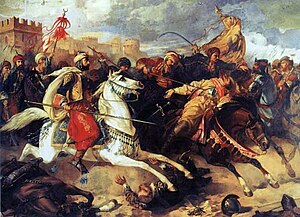 The Crusaders were trapped below. Their defeat permitted the Fall of Constantinople. Beyond the Ottoman Sultan and the Janissaries was the cradle of medieval Bulgaria. | |||||||
| |||||||
| Belligerents | |||||||
| Commanders and leaders | |||||||
| Strength | |||||||
| 16,000[1]–20,000[3][2] | |||||||
| Casualties and losses | |||||||
| minimal[5] or heavy[3] | heavy[3][6][7] | ||||||


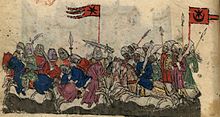
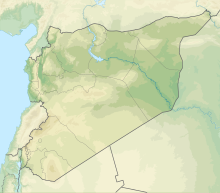

.jpg)


Comments
Post a Comment